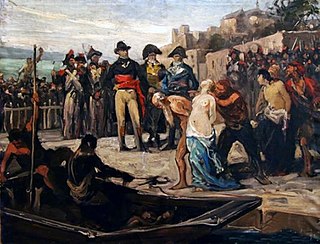合婚刑


合婚刑(法語:mariage républicain,也稱共和國的婚禮)是法國大革命恐怖統治期間在南特的一種處決方式,將一男一女剝光衣服捆綁着,然後將他們淹死。據聞當地的雅各賓派代表讓-巴蒂斯特·卡里耶在1793年11月至1794年1月在南特市下令實施南特溺水處決時產生這一行動[1]。大多數的記錄指出死刑犯在盧瓦爾河被淹死。儘管有一些來源描述另一種替換的行刑方式,先將兩名捆綁的男女用劍刺穿身體[2],而不是在這之後才溺水身亡[3]。
關於這種實施合婚刑的最早記載可以追溯到1794年,當卡里耶因為他的罪行受到審判時,他們很快被同時期的反革命作家如路易-馬里·普呂多姆和路易·德·博納爾德引用[4][5]。
描述
[編輯]
這種行刑的形式歸功於法國革命家讓-巴蒂斯特·卡里耶[6],他被派往南特鎮壓反革命勢力並選派一個革命委員會。一位歷史學家描述這種行刑方法:[註 1]
| “ | 一個革命法庭(在南特)成立了,這其中卡里耶是主持審判的惡魔-卡里耶,這位在所有國家都被稱為最後野蠻暴行的發明人,開創了共和國的婚禮。其中兩個不同性別的人,通常是一個老男人和老女人,或一個年輕男人和年輕女人,奪去了各種各樣的衣服,在群眾面前被捆綁在一起,在那種情況下在船上全身裸露半小時或更長時間,然後扔進河裡溺斃。[6] | ” |
執行的細節稍有不同,但通常與上面描述的一致。一部英國出版的旅遊書,敘述共和國的婚禮是如何將一對男女背靠背捆綁,扒光衣服,讓他們全身裸體一小時,然後將他們投進被鷹犬們稱為「國家大浴缸(法語:la Baignoire Nationale)」的盧瓦爾河里[7]。英國激進派和吉倫特派同情者海倫·瑪麗亞·威廉斯,在1793年至94年的法國政治概述中寫道[8]:
| “ | 無辜的年輕女子在怪物面前一絲不掛;並且,為了給這種地獄的殘忍行為增添更深的恐怖,與一名年輕男子同拴着,兩人都被軍刀砍倒,或被扔進河中。而這種謀殺還被稱為共和國的婚禮。[8] | ” |
根據文學研究學者史蒂文·布萊克莫爾的說法,威廉斯似乎認為這是一種恐怖主義厭女症的形式。威廉斯將這些女性描述為「天真無辜的」,在他看來,「這不僅表明她們沒有幫助叛軍的罪行,而且還證實他們是年輕的處女」。他在威廉斯的文本中爭辯,「男性的雅各賓行刑者被描寫成刑虐式的公共偷窺狂,他們樂於將反革命的男女綁在性交不能的強迫位置上,在一場怪誕的合體之中即時死去。」因此,如果舊制度對威廉斯來說,代表了對女性美貌的強制禁錮,那麽恐怖時期代表了對美貌的貶低死亡[3]。
懷疑論
[編輯]雖然在南特將男子、婦女和兒童的溺斃處決一般沒有爭議。但是人們對合婚刑是否真實存在抱有懷疑,尤其是一些歷史學家,他們宣稱它是一個傳說[9][10]。
聲稱卡里耶下令並實施這一行刑方式的是1794年首次對南特革命委員會進行審判的革命法庭,它出現在查爾斯-吉爾伯特·羅梅的報告、幾封信和證人證詞中。然而,雖然一些人聲稱他們聽過共和國的婚禮,但實際上沒有人見過。一個引用了酒醉船夫的證詞,他使用市民婚禮,但沒有明說死刑犯有無按照性別分配並一同處死[11]。就像助理檢察官和辨方所提到的那樣,沒有足夠證據證明這項特定的指控存在而且陪審團員從起訴書中刪除了。其餘的事實完全足以讓卡里耶和他的幾位密切的同夥被判處死刑。不過,關於共和國婚禮的報道仍然眾所周知,後來研究恐怖統治的作者一一引用,他們很詳細地說明這些內容,例如加上兩名受害者是牧師或修女的說法[9][10][12]。
詞源
[編輯]使用這一術語似乎是對「共和國婚禮(英語:republican marriage)」的嘲諷,因為這是一個真正世俗的婚姻。某些書描述父母驚恐地得知孩子計劃共和婚禮,而非在教堂結婚[13][14][15]。正如一個消息來源描述:
| “ | 當拿破崙和約瑟芬結婚時(1796年3月),「很少有人認為宗教儀式是必要的。人們很容易,他們以非常簡單的方式結婚。以口語的誇張地說,共和國婚姻的儀式是通過圍繞在自由樹跳舞而完成的。離婚則是通過向後繞着同一棵自由樹跳舞來實現的。」[16] | ” |
參見
[編輯]注釋
[編輯]- ^ Ruth Scurr, Fatal Purity: Robespierre And the French Revolution (2006) p. 305.
- ^ William Stafford, English Feminists and Their Opponents in the 1790s: unsex'd and proper females (2002) p. 161.
- ^ 3.0 3.1 Steven Blakemore, Crisis in Representation: Thomas Paine, Mary Wollstonecraft, Helen Maria Williams and the Rewriting of the French Revolution (1997) p. 212.
- ^ Louis-Marie Prudhomme, Histoire Générale Et Impartiale Des Erreurs, Des Fautes Et Des Crimes Commis Pendant La Révolution Française, Tome III (1797), p. vii (referring to "Mariages républicains à Nantes. Deux personnes de différens sexes, nuds, étaient attachées ensemble, on les précipitait ensuite en masse dans la Loire" [Republican marriages in Nantes. Two people of different sexes, nude, were attached together, then put en masse into the Loire].
- ^ "The dreadful invention of the republican marriages passes the genius of man", Louis Gabriel Ambroise de Bonald, Théorie du pouvoir politique et religieux dans la société civile (1796), p. 558.
- ^ 6.0 6.1 Archibald Alison and Edward Sherman Gould, History of Europe from the Commencement of the French Revolution in 1789, to the Restoration of the Bourbons in 1815 (1850) p. 44.
- ^ John Murray, Hand-book for travellers in France (頁面存檔備份,存於網際網路檔案館) (1843), p. 165.
- ^ 8.0 8.1 Helen Maria Williams, Sketch of the Politics of France, 1793–94 (1795), p. 42-43.
- ^ 9.0 9.1 Bertrand, Ernest. 1868. La justice révolutionnaire en France du 17 août 1792 au 12 prairial an III (31 mai 1793), 17:e article, Annuaire de la Société philotechnique, 1868, tome 30, p. 7-92.
- ^ 10.0 10.1 Alain Gérard (1993). La Vendée: 1789–1793. p.265-266
- ^ Title unknown, L'intermediaire des chercheurs et curieux, 1866. P.244
- ^ Brégeon, Jean-Joël. 1987. Carrier et la Terreur nantaise, p.169-171
- ^ John Sartain, et al., Friendship's Offering (1854), p. 271: "No priest dare marry us, dearest, and I cannot respect a republican marriage!"
- ^ Laure Junot Abrantès, Memoirs of the Duchess D'Abrantès (Madame Junot) (1832) p. 294: [asked whether her daughter would be married in a church] "How could you for a moment entertain the idea that not my daughter only, but myself and her brother, could consent to a purely republican marriage?"
- ^ Charles Brockden Brown, The Literary Magazine, and American Register (1804), p. 73: "There are many persons here, who are not content with a republican marriage, but get themselves also privately married by a priest, according to the forms of the Catholic religion".
- ^ Charles MacFarlane, The French Revolution, Vol. III (1845), p. 344.
引文注釋
[編輯]- ^ A Revolutionary Tribunal was established [at Nantes], of which Carrier was the presiding demon—Carrier, known in all nations as the inventor of that last of barbarous atrocities, the Republican Marriage, in which two persons of different genders, generally an old man and an old woman, or a young man and a young woman, bereft of every kind of clothing, were bound together before the multitude, exposed in a boat in that situation for half an hour or more, and then thrown into the river.
